Dr Vino's wine blog
wine talk that goes down easy
Argentina day 1
The itinerary read: arrive Buenos Aires and transfer to Salta. Only it did not note that BA has two airports, one for international flights and one for domestic, about an hour apart by car.
We finessed that problem by spending a few hours in the excellent city in the way that you only can with a car and driver: a half an hour on the shopping street, Florida, where there were a surprising number of shops open for a Sunday; a lunch at Las Lilas in the charming Puerto Madero area, a series of old warehouses along a disused canal that now are residences, offices and restaurants (coincidentally written up in the NYT the same day); a quick stop at a flea market where many cool antiques were displayed and we saw a whole group spontaneously join in with a guitar-bandoneón duo; followed by zooming down the 9 July Avenue, around the obelisk and past the Teatro Colon on a traffic-free ride to the domestic airport.
Salta was two hours by jet to the northwest. Two hours! BIG country! It’s currently dark and drizzling but I still can see the lights of the small city spreading out across the valley floor. More soon….Meanwhile, check out this interactive map of the trip.
Argentina day 0
On board AA 955
Well, this posting may be written on the plane but it’s not going to be posted while I’m on the plane since there’s no internet.
Especially for an airline with a name like AA, the wine choices on the plane are not nearly as dismal as I had expected. A kiwi SB and a Sonoma Chardonnay, a Napa cab and the Luigi Bosca Malbec DOC. Somehow I thought they might be so diplomatically insensitive as to serve Chilean merlot!
 tags: wine | American Airlines
tags: wine | American Airlines
Mendoza and me
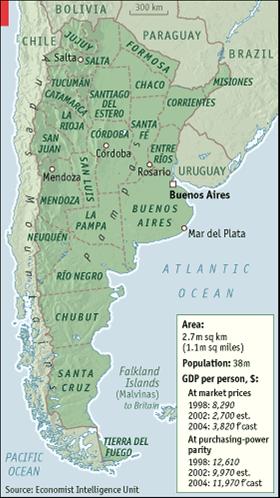
Don’t cry for me — I’m going to Argentina.
This time next week, I’ll be riding across the pampas. OK, most likely in a van and inspecting vineyards, not cattle, but I’ll do my best gaucho impression anyway.
I’m joining a press trip organized by the Wines of Argentina trade group. We first head to Salta, an expansive and beautiful region in the northwest that borders Bolivia and Chile. Then we’ll transit to Mendoza, the epicenter of Argentine wine making at the foothills of the Andes. Then it’s back to Buenos Aires and its wine bars before hopping on the plane home.
I’m looking forward to hopefully meeting Susana Balbo and posting another (overdue!) installment in the Real Wine World.
The reason I mention this now is not to get you green with envy. Rather, if you have any questions you’d like me to ask or suggestions for travel let me know before I go. I’ll do my best to keep you posted in real time via the blog but I’m not sure where we’ll stand on the axis of internet connection/deprivation.
I look forward to getting the latest from this exciting part of the wine world. There’s been so much change over the last few years with the currency collapse, rising quality, and increasing internationalization. Heck, the president is even calling on Argentines to eat less beef!
Map source: The Economist
 tags: wine | Argentine wine | Argentina
tags: wine | Argentine wine | Argentina
Terrazas de los Andes, Malbec, 2004
Terrazas de los Andes, Malbec 2004. $9. Find this wine
Polyphenols, they’re all the rage. No, they’re not a chemical additive dumped into wines by industrial wine makers; instead they are chemical compounds, high in antioxidants, that may fight cancer. Since polyphenols occur naturally in red wines, enthusiasts and the producers of red wine have been quick to make tout the health benefits of red wine (yes, something we enjoy doing may actually be good for us). According to a 2001 study in the magazine Nature, the high elevation of the Argentine vineyards gives their reds more exposure to ultraviolet rays and raises the polyphenol level. So don’t reach for a bottle of POM pomegranate juice, reach for an Argentine Malbec. This Terrazas is a great place to start. After tasting through a half a dozen entry-level Malbecs, I found this 100% Malbec grown at 3,000 ft above sea-level to be the most attractive. Dark in color, with notes of blackberry, plum, cassis, and saddle leather, and the tannins in the finish were smooth. The obvious food pairing is a steak but would also be good with burgers. Importer: Schieffelin & Somerset NY.
 tags: wine | wine picks | Malbec
tags: wine | wine picks | Malbec
Ed Lehrman, Susana Balbo’s American importer
With Susana on vacation this month, I thought we could hear from her American importer, Vine Connections. Partner Ed Lehrman spoke to me from his office in Sausalito last week.
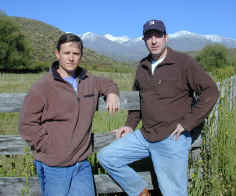 When Ed Lehrman goes to Mendoza, he stays in a hotel for half the normal tourist price. How? He lets one of his local producers make the hotel bookings for him. That’s one of the tricks of the trade Ed has learned over the past five years as he has established his company as one of the strongest importers of Argentine wines to the US.
When Ed Lehrman goes to Mendoza, he stays in a hotel for half the normal tourist price. How? He lets one of his local producers make the hotel bookings for him. That’s one of the tricks of the trade Ed has learned over the past five years as he has established his company as one of the strongest importers of Argentine wines to the US.
In 1999, Ed went on a fateful journey to Argentina. He had just sold his wine retail business and decided to join one of his distributors, Nick Ramkowsky, on a trip to South America. Although they only spent five days in Argentina and neither spoke much Spanish, they were so impressed by what they saw and tasted that they decided to go into business together and start importing the wines of Argentina to the US.
Ed tasted 3,000 wines a year in his retail business, a company for mail order wine, and Nick tasted a lot too. But when they were sampling in Mendoza, “He looked at me and I looked at him, and we agreed that this is far different from wines we know as Argentine—we have to do something about this,” Ed recalled on the phone last week from his office in Sausalito, CA.
“Susana’s wines were the ones that made the biggest mark. Here was a very talented wine maker whose wines weren’t being exported.”
“Argentina in late 1990s was similar to Napa in late 1970s since people were just developing a sense of their own brands and what they had to achieve. They still are today. Really only since 1994 have they been making quality wines for export,” Ed said.
It was a hard time to make quality wine at all. There wasn’t much domestic demand for it despite the fact that Argentina has one of the highest per capita consumption rates in the world. “The Argentine consumer doesn’t have tradition of paying up. Susana stuck to high quality. Thus the benefit for her was to go to the export market and show what she can do,” Ed said.
With their knowledge of the US market and its quirks, as well as packaging and sales, Ed and Nick set up Vine Connections and started importing the wines of Argentina. Armed with color printouts of their labels, and samples of their 12 wines, they started knocking on doors to set up a distributor network from scratch. They met with tremendous enthusiasm and acceptance even though the wines were priced aggressively for a relatively unknown country starting at $22 for the BenMarco Malbec and going up to $50 retail. “Price points weren’t as tough as they are today,” Ed said.
Today VineConnections has a presence in 45 states. His portfolio of wines now is almost entirely dedicated to the wines of Argentina since Ed says that as an importer “it is increasingly difficult to be a generalist.” The Vine Connections portfolio also includes the wines of Ernesto and Laura Catena, Tikal and Luca respectively, both the children of Argentine wine pioneer, Nicolas Catena. And they are also importers of several dozen premium sakes from Japan.
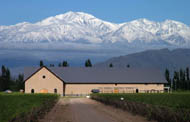 Ed describes Dominio del Plata, the winery that Susana built with her husband Pedro, as more comfortable and homey than other, more luxurious wineries. They built it right among their vineyards and also included a residential space in the winery so from their dining room windows, you can see the fermentation tanks. And it’s location on the way to the pass through the Andes to Chile, makes it very convenient. It’s small wonder that one thing on Susana’s plate for the next year is thinking how to better handle tourism requests.
Ed describes Dominio del Plata, the winery that Susana built with her husband Pedro, as more comfortable and homey than other, more luxurious wineries. They built it right among their vineyards and also included a residential space in the winery so from their dining room windows, you can see the fermentation tanks. And it’s location on the way to the pass through the Andes to Chile, makes it very convenient. It’s small wonder that one thing on Susana’s plate for the next year is thinking how to better handle tourism requests.
Single vineyard wines are more risky in Argentina than they are in other parts of the wine world because of the risk of a snap hail storm, which can decimate a crop in 15 minutes. He cited staggering figures of a 13% annual loss rate of the total Mendoza grape crop over the last 20 years. Thus producers tend to source their grapes from several growing sites to diversify the risk. And they also resort to hail netting and even cannons, whose blasts are thought to break up hail squalls.
Despite this hail risk, which is manageable, Ed does not envy his fellow wine importers who import wines from France and Italy. “From a business standpoint, I’m not sure I would want to face the vagaries of the weather. The climate in Mendoza is similar to California. There certainly is vintage variation. Overall if you look at the consistency and quality you can achieve, it is great. We thought about the downside and there was very little.”
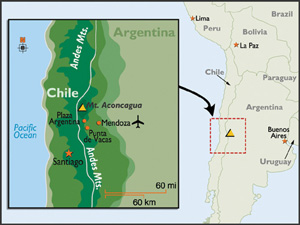 Snow, of all natural factors, has played a role in their business recently. To ship their wines to the US, Ed and Nick use the port of San Antonio, Chile. Getting there from Mendoza, trucks laden with the wine of Susana and their other producers must bypass Aconcagua, the highest mountain in the Western Hempisphere, and scale the Uspallata pass at 12,500 feet. In the summer, climbing this height takes only a few tanks of gas but is no great obstacle. However, now, when it is winter down under, it has become a bottleneck.
Snow, of all natural factors, has played a role in their business recently. To ship their wines to the US, Ed and Nick use the port of San Antonio, Chile. Getting there from Mendoza, trucks laden with the wine of Susana and their other producers must bypass Aconcagua, the highest mountain in the Western Hempisphere, and scale the Uspallata pass at 12,500 feet. In the summer, climbing this height takes only a few tanks of gas but is no great obstacle. However, now, when it is winter down under, it has become a bottleneck.
“It’s been hard to even find containers to fill,” Ed laments because the traffic has been so backed up this winter because of the tremendous snowfall. Normally, the pass can close for a day or two in the winter but this winter it has been closed for up to two weeks at a time. Nonetheless, ships departing every two weeks means that they don’t have to wait for a boat once they clear the Andes.
Once the wines arrive in the US, the Vine Connections team is on the road selling the wines. Ed says that he travels less than Nick since he has two children but he is still on the road about 100 days a year. Nick has been shouldering as many as 280 days a year on the road, though he will be pulling back with the hiring of new sales staff bringing their national total up to seven. It’s important for Ed and Nick that their sales staff feel the same enthusiasm for Argentina that they do so all of the staff have been there to experience it first-hand.
Ed and Nick were drawn to Argentina in 1999 by the wines but in 2002 many others were drawn by the currency collapse. “When we went from the first time, we thought we had found the Holy Grail, to make good wine consistently, and we thought we could have the place to ourselves for quite a while. But now Argentina is so much on the map and the number of foreigners who have moved in has been phenomenal. No major wine growing country is without some sort of presence,” Ed said. “I’m stunned that it took the world this long to find out.”
Susana Balbo, making wine in Mendoza
It was 25 degrees (-6C) in Mendoza on the morning that I reached Susana Balbo by phone last week. Nestled in the foothills of the Andes, the vineyard was dotted with workers pruning the vines down to stumps she said. But the winery itself was in its annual hibernation as the grapes were harvested two months ago and the wines were quietly fermenting.
Although she and her husband, Pedro Marchevsky, started making their own wines in 1999, it wasn’t until 2001 that their striking winery, Dominio del Plata, which Susana designed, opened for making her three lines of wines. The wines include Malbec, Argentina’s signature grape, as well as more unusual offerings including Syrah-Bonarda, a rosé from Malbec, and the white Torrontés. They range from about $10 to $35 retail in the US and can be found in 17 countries.
 Export markets have been essential for Susana since the concept stage of the winery. Her first winery, a short-lived venture in the early nineties, targeted the large domestic market in Argentina. Since then, exporting has become not only easier but essential. For example, when the Argentine peso collapsed in 2002 losing 75 percent of its value against the dollar, wineries with strong exports profiles actually saw their sales rise in peso terms (see my backgrounder).
Export markets have been essential for Susana since the concept stage of the winery. Her first winery, a short-lived venture in the early nineties, targeted the large domestic market in Argentina. Since then, exporting has become not only easier but essential. For example, when the Argentine peso collapsed in 2002 losing 75 percent of its value against the dollar, wineries with strong exports profiles actually saw their sales rise in peso terms (see my backgrounder).
A graduate in enology in 1981, Susana honed her winemaking skills during nine years in the Cafayate province. She returned to Mendoza in 1990 and refined her export skills as export manager during the mid-to-late nineties at Catena, one of the locomotives of the Argentine wine industry. She also designed the new Catena winery, a useful base for later designing her own. And she also met her husband there, since Pedro was the long-time vineyard manager at Catena, and the two were married in 1995. But they both left Catena to pursue their own winery together.
Susana is careful to draw on her experience at Catena but not the contacts that she made there. Her American exporter, Vine Connections, is a different importer than Catena’s American importer, an important point for Susana. She also maintains different importers in Europe than Catena. “All professionals want their own boats, to be their own captain,” she says.
The popularity of the wines abroad is having ramifications at home. In one way, Susana is starting to see more demand from the domestic market. As Argentines travel abroad again now that the economy is on a firmer footing, they are seeing her wines overseas and then come home and look for them. Further, foreign consumers are increasingly traveling to Argentina and the winery gets many calls for visits, but can hardly accommodate any of them. That’s something that Susana would like to work on more in the next year.
She also aims to do more experimentation in the vineyard. The 25 acres of vines are managed according to sustainable agriculture practices. But the real wild card in grape growing in Mendoza is the risk of hail storms that can erupt without warning just before harvest time, pound the plump grapes, and leave the vineyard owner with no crop. Thus Susana is trying strategic placements of nets of various colors and densities.
The winery is a family affair with Susana making the wines, while Pedro and his son manage the vineyards. Pedro’s daughter-in-law is an artist and designs all the labels. Susana’s son is currently a student at the University of California at Davis, the premier school for winemaking and viticulture in the US. One of the wines is called “Crios,” which means offspring and the label depicts two small hands in a big one symbolizing Susana and her two (now grown) children.
Susana is headed to Davis to visit her son and then take some time relaxing on the beach in northern Brazil. We’ll check in with her American importer next month. Over the coming year, I’ll talk with Susana more about the making and selling of wine and hopefully meet up with her in Argentina or America to see her doing one of the two.
New Reality Project Tracks “a Year in the Life of†Three Wine Industry Participants
June 29, 2005
New York, NY – What does it take to be a wine producer? Or an importer? Or a retailer? Discover the inside scoop through a “year in the life of” three accomplished wine industry professionals. The new initiative, The Real Wine World, launches today on DrVino.com.
Taking a page from the reality TV playbook, the project will track three industry participants for a year. Susana Balbo makes wines in Mendoza, Argentina. Gregory Smolik of Chicago imports artisan Italian wines. And Patricia Savoie, owner of Big Nose, Full Body, who sells wines from all over the world at its neighborhood location in Brooklyn, NY.
Over the course of the year, the project will track the participants as they make or sell wine. They will offer insight into the industry, whether on technical winemaking questions or what works for selling wine. Further, the two non-producers will serve as an example of how to start-up professionally in the wine industry without owning or working at a winery.
The project is conceived and written by Tyler Colman (Ph.D., Northwestern). Colman is working on a book about the politics of wine in France and America. As a freelance wine writer with articles in consumer and trade publications, he writes about the business and politics of wine. He currently teaches classes on wine and politics at both University of Chicago and New York University.
Welcome to The Real Wine World
June 29, 2005
What does it take to be a wine producer? Or an importer? Or a retailer? Discover the inside scoop through “a year in the life of” three accomplished wine industry professionals. In this space, we will track one year of making and selling wine in three different parts of the world and watch how they do their business and overcome challenges.
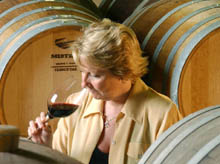
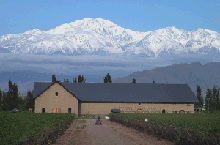 From Argentina, Susana Balbo brings 25 years of winemaking experience to her wines in Mendoza. She and her husband, Pedro Marchevsky, the vineyard manager, started their winery in 1999. The practice sustainable agriculture and export 90 percent of their wines to 17 countries. The winery is currently running near its capacity so how the manage their production, and the increasing number of tourists the wines attract, are key challenges for the coming year.
From Argentina, Susana Balbo brings 25 years of winemaking experience to her wines in Mendoza. She and her husband, Pedro Marchevsky, the vineyard manager, started their winery in 1999. The practice sustainable agriculture and export 90 percent of their wines to 17 countries. The winery is currently running near its capacity so how the manage their production, and the increasing number of tourists the wines attract, are key challenges for the coming year.
Susana Balbo, Making wine in Mendoza 6/29/05
 In America, Gergory Smolik started his own wine importing company in Chicago in January 2004. He imports wines from four regions of Italy all from family-run wineries that produce only limited amounts of wine each year. Smolik believes in rustic authenticity. Prior to starting his own business, Greg was the Italian wine buyer for six years at Sam’s Wines in Chicago. In the coming year, he expects to grow his list of producing wineries and expand the availabillity of his wines in the US.
In America, Gergory Smolik started his own wine importing company in Chicago in January 2004. He imports wines from four regions of Italy all from family-run wineries that produce only limited amounts of wine each year. Smolik believes in rustic authenticity. Prior to starting his own business, Greg was the Italian wine buyer for six years at Sam’s Wines in Chicago. In the coming year, he expects to grow his list of producing wineries and expand the availabillity of his wines in the US.
Gregory Smolik, Importing artisanal wines from Italy 6/29/05

Big Nose, Full Body is a wine shop in the Park Slope area of Brooklyn, NY. The shop is celebrating its fifth anniversary this year; Patricia Savoie, the current owner, purchased the shop two years ago. Since then it has won various accolades as well as a loyal following in the neighborhood. The small, smart shop stocks around 350 wines from around the world mainly in the $8 – $15 price range. With wines from off the beaten path places such as Turkey and California Charbono, Pat says “we have good breadth, not depth” to describe her store’s offering.




